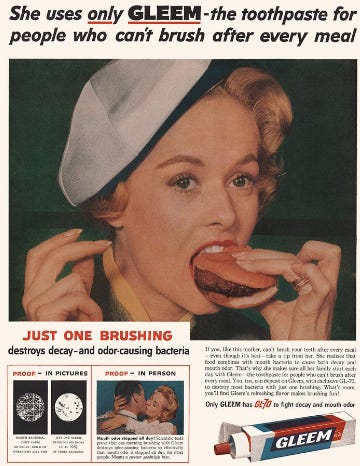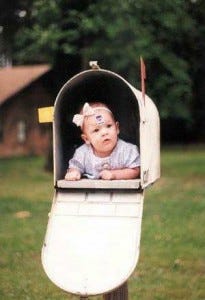October 3, 2023 - Waves, Big Bears, Brushing, Babies
After eating a nuked salmon Hot Pocket, be sure to brush your baby's teeth before applying the Forever Stamps.
Nuggets of Information: Let’s Catch Some Rad Waves Dude!
While Instant Pots, Air Fryers and George Foreman Grills may be the hip trendy cooking appliances of today’s nouveau riche, I’d like to take a minute to give a little love to the humble microwave oven. The first component to be developed was the magnetron, used to generate short electromagnetic waves used for radar during World War II. In 1945, American engineer Percy Spencer was working on an active radar set and noticed a Mr. Goodbar he had in his pocket had started to melt. This led to additional testing, with popcorn going first, then an egg, which promptly exploded. If I had to guess the third item they tested, I’d go with Peeps.
You may be thinking – this is powered by dark magic, right? Nope! A microwave oven works by using electromagnetic radiation to heat food. The radiation is generated by a magnetron inside the oven, which produces microwaves, which are a type of radio wave. Microwaves have a wavelength of about 1-10 centimeters, which is much longer than the wavelength of visible light.
When microwaves hit food, they cause the water molecules in the food to vibrate. The vibration causes the food to heat up. The microwaves also cause the fat molecules in the food to vibrate, which also causes the food to heat up. This video does a great job explaining in more depth how microwaves work. One fact I didn’t know was that the different power settings you can choose are basically timers for when the magnetron is on or off.
One rule for microwaves is to not use them to cook fish in the company break room, unless you are warming up the sockeye salmon you plan to give to the skinny bear who sits in the cubicle next to you.
Enrichment: I Like Big Bears and I Can Not Lie
This week the US National Park Service runs their annual “Fat Bear Contest” where pictures of bears packing on the pre-hibernation pounds are shared, and the world votes on a champion. This is high drama stuff. Since the inaugural contest in 2014, bear “480 Otis” has won four times, most recently in 2021. But bear “747” won in 2020 and 2022. In 2021, they added a Fat Bear Junior category, where you can vote for your favorite “chubby cubbie.” Sigh. Yeah. There you go.
The contest focuses on bears in the Katmai National Park & Preserve in Alaska. This area features the largest run of sockeye salmon in the world, providing the perfect sustenance for the bears. Their goal is to eat as much as possible, loading up the fat stores that will sustain them through the winter. I take the same approach when dining at Fogo de Chão. I swear I’m only going to eat the meats, but that salad bar is really good. And hey can we get another basket of those little Pão de queijo cheesy rolls? Winter is coming!
During their hibernation period, bears can lose up to a third of their body weight. If they combine that with CrossFit, they can lose even more, but then end up annoying people when all they ever talk about is how many rope-climbs they did in their WOD.
To follow all the action and vote on your favorite big-boned ursine beauty, go to explore.org.
Workshop: Forgive Me for Being a Little Long in the Tooth
In following my mission of bringing you content about things you already know about, like walking, breathing and sleeping, next up is “brushing your teeth.”
Good oral hygiene has numerous health benefits. Millions of bacteria live in your mouth, but most are harmless. However, some bacteria can cause disease, especially if you have poor oral hygiene. Without proper hygiene, bacteria can multiply and cause infections such as tooth decay and gum disease. Studies suggest that oral bacteria and inflammation associated with severe gum disease may play a role in other diseases, such as heart disease, stroke, diabetes, and Alzheimer's disease.
Some medications, such as decongestants, antihistamines, painkillers, diuretics, and antidepressants, can reduce saliva flow. Saliva helps to wash away food and neutralize acids produced by bacteria in the mouth. Without enough saliva, bacteria can grow more easily and lead to disease.
Now that I’ve covered the why, do I even need to tell you the how? We all know how to brush our teeth, right? Well … maybe. First let’s cover the process. For most of my life, I thought the steps were:
Squeeze out a long ribbon of toothpaste onto the brush.
Brush teeth.
Spit out toothpaste.
Rinse out mouth with water.
Mouthwash (optional).
There are a couple things wrong with this. First – I was using way too much toothpaste. Unlike how Big Toothpaste depicts how much you should use in their advertisements, you really only need a small bead-sized dollop of paste. Think small garbanzo - not big gigante.
Next mistake – after you spit, don't rinse your mouth after brushing. The ingredients in toothpaste are there for a reason – leave that goodness in your mouth. If you like mouthwash – great – but do that FIRST not last. Use mouthwash to … wash your mouth, THEN brush your teeth.
Boo’s N.E.W.S. reader and “Sharing is Caring” champion Doug Keller submitted a question about one of the dark sides of the mouth care regimen: Why does orange juice taste so bad after you brush your teeth? It starts with a key ingredient in toothpaste: sodium laurel sulfate (SLS). SLS is a surfactant – a type of soap that creates suds/foam while you brush and helps get those teeth clean. A couple things happen when SLS is in your mouth. First, it suppresses the receptors on your tongue that pick up on sweet flavors, neutralizing the sweetness of the orange juice. Second, it interferes with phospholipids, fatty compounds that help reduce bitter tastes. Basically, toothpaste blocks the sweetness of the orange juice, letting only the full and complete bitterness to come through. Bleh!
You could decide to skip brushing and go all in on Team Orange Juice, and that may be okay. Japanese scientists will begin human trials next year on a drug that stimulates the growth of new teeth.
Selected Content: Signed, Sealed, Delivered, I’m Yours
Boo’s N.E.W.S. long-time reader and my even longer-time sister Bridget Booher shares this awesome article about the US Postal Service’s introduction of Parcel Post, and how people pretty much immediately saw this as the solution to the age-old problem “How can I send a baby across the country?”
The article explains that 1910-1920 was the Golden Age of baby-mailing, until some spoilsports ended the practice in 1920. My favorite part of the article is a clipping from the San Francisco Examiner from 1914, offering some best practices for shipping infants:
It goes without saying that I find some parts of this very objectionable. “Not advisable to give babies frankfurters or boiled dinners”? “Do not stick stamps on baby’s face”? Trust me – I have found that if you don’t give baby an Oscar Mayer wiener to nibble on, baby will never sit still for a good face stamping.
“Well what can I ship to an unsuspecting friend as a harmless prank?” Good question! I checked!! You can ship live scorpions, live bees, poop, live baby geese, poison, cremated remains, a potato, and a hula hoop. If you are thinking of mailing me something unusual, there are lots of great choices at Snake River Farms.
Thanks for reading! If you enjoyed this, please share it on social media!









palate. Third time's the charm. Ha!!
palette.